Sustainable Development Goal 16
Sustainable Development Goal 16 (SDG 16 or Global Goal 16) is about "peace, justice and strong institutions." One of the 17 Sustainable Development Goals established by the United Nations in 2015, the official wording is: "Promote peaceful and inclusive societies for sustainable development, provide access to justice for all and build effective, accountable and inclusive institutions at all levels".[1] The Goal has 12 targets to be achieved by 2030. Progress towards targets will be measured by 23 indicators.
| Sustainable Development Goal 16 | |
|---|---|
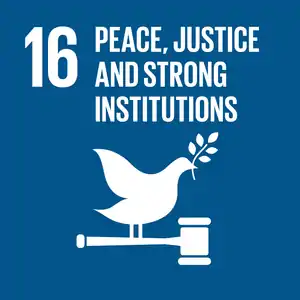 | |
| Mission statement | "Promote peaceful and inclusive societies for sustainable development, provide access to justice for all and build effective, accountable and inclusive institutions at all levels" |
| Commercial? | No |
| Type of project | Non-Profit |
| Location | Global |
| Owner | Supported by United Nations & Owned by community |
| Founder | United Nations |
| Established | 2015 |
| Website | sdgs |
The goal has ten "outcome targets": Reduce violence; protect children from abuse, exploitation, trafficking and violence; promote the rule of law and ensure equal access to justice; combat organized crime and illicit financial and arms flows, substantially reduce corruption and bribery; develop effective, accountable and transparent institutions; ensure responsive, inclusive and representative decision-making; strengthen the participation in global governance; provide universal legal identity; ensure public access to information and protect fundamental freedoms. There are also two "means of achieving targets": Strengthen national institutions to prevent violence and combat crime and terrorism; promote and enforce non-discriminatory laws and policies.[2]
Reducing violent crime, sex trafficking, forced labor, and child abuse are clear global goals. The International Community values peace and justice; they call for stronger judicial systems that will enforce laws and work toward a more peaceful and just society.[1]
All women need to be able to turn to fair and effective institution to access Justice and important services.[3] We cannot hope for sustainable development without peace and stability in any country.[4]
Background
The Sustainable Development Goals are a collection of 17 global goals set by the United Nations. It is an engine for progress and an enabling tool for all other goals.[5] The broad goals are interrelated though each has its own targets to achieve. The SDGs cover a broad range of social and economic development issues. These include poverty, hunger, health, education, climate change, gender equality, Water supply, sanitation, energy, urbanization, environment and social justice.[6] The SDGs include an emphasis on the importance of achieving progress on peaceful and inclusive societies, access to justice and rule of law, and effective, accountable and inclusive institutions.[7]
SDG 16 addresses the need for major intervention to promote peace and inclusive institutions and contribute to the other Sustainable Development Goals. Areas of improvement include: reducing lethal violence, reducing civilian deaths in conflicts, and eliminating human trafficking.[8]
The UNODC reports that in 2017 alone, around 464,000 people were victims of intentional homicide and homicide rates were 6.1 per 100,000.[9] Two thirds of global homicides occur in Latin America and the Caribbeans or sub-Saharan Africa.[10] Poverty, economic inequality, and high youth unemployment are some of the major reasons behind the high homicide rates in Latin America.[11] The UNODC found that, homicides are four times morel likely to occur in regions with high economic disparity than those that have economic equity, which helps to explain the high homicide rates in some Latin American regions.[12] Although homicide rates have been seeing a reduction the past several years,[8] the progress on SDG 16 has been reversing. If current global trends continue, it is estimated that all forms of violence will increase by 10-46 percent by 2030.[13]
Targets, Indicators and progress
SDG 16 has twelve targets and twenty-four indicators. Three of the targets specify their agenda by the year 2030. Below is the list of all the targets with a short version and a long version of the titles.[7][14]Ritchie, Roser, Mispy, Ortiz-Ospina. "Measuring progress towards the Sustainable Development Goals." (SDG 16) SDG-ああああああFile:Homicide rate.png|thumb|300x300px|World map for 16.1.1 - Number of victims of intentional homicide per 100,000 population in 2016]] No data is available yet for the following indicators: 16.4.1, 16.4.2, 16.6.2, 16.7.1, 16.7.2, 16.b.1.[14] For all the other indicators, data and world maps are available to visualize progress.[14]
Target 16.1: Reduce violence everywhere
Long title: "Significantly reduce all forms of violence and related death rates everywhere."[7]
This target has four indicators:[14]
- Indicator 16.1.1 Number of victims of intentional homicide per 100,000 population, by sex and age.
- Indicator 16.1.2 Conflict-related deaths per 100,000 population, by sex, age and cause.
- Indicator 16.1.3 Proportion of population subjected to (a) physical violence, (b) psychological violence and (c) sexual violence in the previous 12 months.
- Indicator 16.1.4 Proportion of population that feel safe walking alone around the area they live.
Honour based violence (HBV) is classified as not only murder or violence, but rather a heroic attainment of religious beliefs, typically committed by a male family member. The United Nations estimates that around 5,000 women are killed annually in relation to HBV. However, the actual number is several times higher due to weak administration of these crimes. Authorities are reluctant to report statistics that could potentially affect their international reputation or are bribed in order to protect the family's reputation.[15] Target 16.5 indicates instills the concept of bribery further, and Target 16.2 portrays the lack of crime reported.
Where conflict strikes, men are more likely to die on battlefields, but women will be targeted for sexual violence, exploitation and other violation.[16] economic growth is affected by violence.[17]

A survey conducted in Kuwait measures both support and opposition for HBV crimes in correlation with demographic attributes (age, sex, education) and social indicators (status, religion). The survey indicated high levels of public support in justifying physical violence towards female adultery or for transgression of female gender norms. One of the strongest attributes are aligned with political Islam. In a revision of 172 honour-killings, more than half occurred in Muslim-majority countries and 91% of the perpetrators were Muslim.[18]
UNICEF, as well as indicator 16.1.3, classifies violence into three categories: physical, psychological, and sexual. Save the Children, a non-governmental organization aimed to help vulnerable adolescents in Bolivia who fit at least one classification of violence through modules as follows:
- Module 1- Self-esteem, personal empowerment, and leadership
- Module 2- Sexual and reproductive health
- Module 3- Entrepreneurial skills and economic empowerment
- Module 4- Basic competences; math and literacy
The program was found to have had a positive effect for success for females, with an improvement in bargaining power within the household and reduction in income-related stress. Additionally, this program may be a factor that led to the decrease in violence against girls in Bolivia. [19]
Target 16.2: Protect children from abuse, exploitation, trafficking and violence
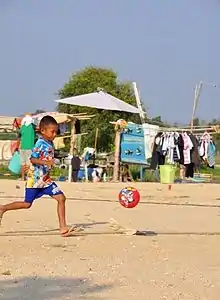
Long title: "End abuse, exploitation, trafficking and all forms of violence against and torture of children."[7] It ensures that children are better served.[20]
This target has three indicators:[14]
- Indicator 16.2.1: Proportion of children aged 1–17 years who experienced any physical punishment and/or psychological aggression by caregivers in the past month.
- Indicator 16.2.2: Number of victims of human trafficking per 100,000 population, by sex, age and form of exploitation.
- Indicator 16.2.3: Proportion of young women and men aged 18–29 years who experienced sexual violence by age 18.
One target is to see the end to sex trafficking, forced labor, and all forms of violence against and torture of children. However, reliance on the indicator of "crimes reported" makes monitoring and achieving this goal challenging.[21] For instance, 84 percent of countries have no or insufficient data on violent punishment of children.[22] Of the data available, it is clear that violence against children by their caregivers remains pervasive: Nearly 8 in 10 children aged 1 to 14 are subjected to violent discipline on a regular basis (regardless of income).[22] The global pandemic has magnified the challenges of child protection and mental health services, instead of prioritizing them. With this occurring in the world currently, no country is on track to eliminate all forms of violence and to promote mental health and well-being as the 2030 Agenda for Sustainable Development pledges.[23]
By 2017, the UN could report progress on detecting victims of trafficking. More women and girls than men and boys were victimized, yet the share of women and girls has slowly declined (see also violence against women). In 2004, 84 percent of victims were females and by 2014 that number had dropped to 71 percent. Sexual exploitation numbers have declined, but forced labor has increased.[22]
Every 7 minutes, a child somewhere around the world through violence is killed and about one out of four children's birth are never recorded, which makes them at the long run feel deprived of legal identity which is important for the protection of their right to Justice and social services[24]
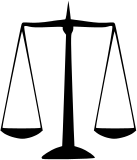
Target 16.3: Promote the rule of law and ensure equal access to justice
The full text of Target 16.3: "Promote the rule of law at the national and international levels and ensure equal access to justice for all."[7]
This target has three indicators:[14]
- Indicator 16.3.1: Proportion of victims of violence in the previous 12 months who reported their victimization to competent authorities or other officially recognized conflict resolution mechanisms.
- Indicator 16.3.2: Unsentenced detainees as a proportion of overall prison population.
- Indicator 16.3.3: Proportion of the population who have experienced a dispute in the past two years and who accessed a formal or informal dispute resolution mechanism, by type of mechanism.
One of the aims of indicator 16.3.1 in measuring the "proportion of victims of violence in the previous 12 months who reported their victimization" is to reduce the underreporting of crime and acts of violence. The lack of an official data source poses a great challenge for accurately measuring the progress on this indicator across the globe. For Africa, the Afrobarometer serves as a significant source of data for indicator 16.3.1; however, data is only available from the years 2011-2013. According to the surveys conducted by Afrobarometer, where in which surveyees were asked "Did you report the incident to the police?", the Institute for Economics and Peace (IEP) finds that "30 per cent or less of all violence incidents were reported to the police" in 6 of 32 African countries with available data, as well as another 6 African countries where "60 per cent of incidents were reported to the police."[25]
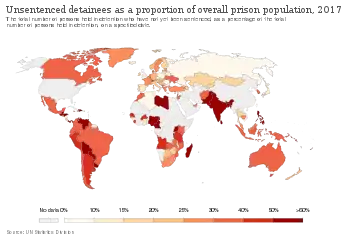
Regarding indicator 16.3.2, the IEP further concludes that of the 149 countries with available data, 31 countries had "a rate lower lower than 15 per cent" and 62 had "a rate higher than 35 per cent."[25] Asia and Oceania countries experienced high increases in rates during the years 2016-2018.[26] The COVID-19 pandemic has further complicated the access to justice for unsentenced detainees who make up 31 per cent of all prisoners. Prison overcrowding combined with poor health care leaves prisoners vulnerable to COVID-19.[27]
Target 16.4: Combat organized crime and illicit financial and arms flows
The full text of Target 16.4: "By 2030, significantly reduce illicit financial and arms flows, strengthen the recovery and return of stolen assets and combat all forms of organized crime."[7]
The target has two indicators:[14]
- Indicator 16.4.1: Total value of inward and outward illicit financial flows (in current United States dollars).
- Indicator 16.4.2: Proportion of seized, found or surrendered arms whose illicit origin or context has been traced or established by a competent authority in line with international instruments.
Target 16.5: Substantially reduce corruption and bribery
The full text of Target 16.5: "Substantially reduce corruption and bribery in all their forms."[7]
The target has two indicators:[14]
- Indicator 16.5.1: Proportion of persons who had at least one contact with a public official and who paid a bribe to a public official, or were asked for a bribe by those public officials, during the previous 12 months.
- Indicator 16.5.2: Proportion of businesses that had at least one contact with a public official and that paid a bribe to a public official, or were asked for a bribe by those public officials during the previous 12 months.
Based on available data from 38 countries collected in years 2010-2020, bribery when accessing public services was least present (at an average rate of 3.7 per cent) in high-income countries and most present (at an average of 22.3 per cent) in lower-income countries.[26]
Target 16.6: Develop effective, accountable and transparent institutions
The full text of Target 16.6: "Develop effective, accountable and transparent institutions at all levels."[7]
The target has two indicators:[14]
- Indicator 16.6.1: Primary government expenditures as a proportion of original approved budget, by sector (or by budget codes or similar).
- Indicator 16.6.2: Proportion of population satisfied with their last experience of public services.
Target 16.7: Ensure responsive, inclusive and representative decision-making
The full text of Target 16.7: "Ensure responsive, inclusive, participatory and representative decision-making at all levels."[7]
The target has two indicators:[14]
- Indicator 16.7.1: Proportions of positions in national and local institutions, including (a) the legislatures; (b) the public service; and (c) the judiciary, compared to national distributions, by sex, age, persons with disabilities and population groups.
- Indicator 16.7.2: Proportion of population who believe decision-making is inclusive and responsive, by sex, age, disability and population group.
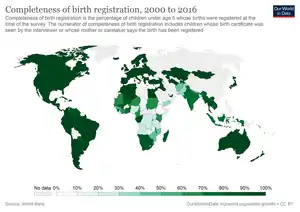
Target 16.8: Strengthen the participation in global governance
The full text of Target 16.8: "Broaden and strengthen the participation of developing countries in the institutions of global governance."[7] The target has a single indicator.
Indicator 16.8.1 is the "Proportion of members and voting rights of developing countries in international organizations".[14]
Target 16.9: Provide universal legal identity
The full text of Target 16.9: "By 2030, provide legal identity for all, including birth registration."[7] It has one indicator:
Indicator 16.9.1 is the "Proportion of children under 5 years of age whose births have been registered with a civil authority, by age".
Different businesses are evaluating the addition of target 16.9 according to their priorities, categories include child protection, economic development, national security, social protection, public health, and so forth. Individuals without proof of legal identity, primarily women and the less fortunate are excluded from the economy.
Target 16.9 overlaps with other SDG targets. For instance, Target 1.3 which implements social protection systems can not be nationally addressed without the vulnerable being able to identify themselves. This is also affiliated with SDG 3 in terms of healthcare and SDG 4 in terms of education. A lack of legal identity can prevent numerous measures that are put in effect to benefit individuals who require it most, creating higher rates of inequality.[29] With more than a quarter of children under 5 unregistered worldwide as of 2015, about 1 in 5 countries will need to accelerate progress to achieve universal birth registration by 2030.[30]
Target 16.10: Ensure public access to information and protect fundamental freedoms
The full text of Target 16.10: "Ensure public access to information and protect fundamental freedoms, in accordance with national legislation and international agreements."[7]
The target has two indicators:[14]
- Indicator 16.10.1 Number of verified cases of killing, kidnapping, enforced disappearance, arbitrary detention and torture of journalists, associated media personnel, trade unionists and human rights advocates in the previous 12 months.
- Indicator 16.10.2 Number of countries that adopt and implement constitutional, statutory and/or policy guarantees for public access to information.
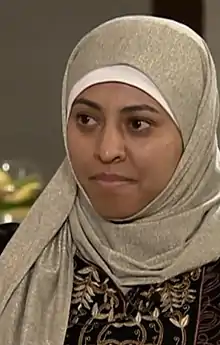
Rights to information is a fundamental piece of the Universal Declaration of Human Rights.[31] In 2019, the United Nations Educational, Scientific, and Cultural Organization (UNESCO) found that 125 countries have chosen to take up Right to Information(RTI), Access to Information(ATI), or Freedom to Information(FTI) laws or equivalent guarantees. Seventeen countries were found to not have any sort of laws or promises in favor of public access to information. Although a majority of countries globally have adopted RTI related policies, UNESCO identified an issue regarding the sustainability in monitoring and reporting practices on target 16.10. They called for the implementation of oversight bodies, specifically, giving them leadership positions on overseeing progress on the SDG’s nationally.[32]
The importance of progressing target 16.10 can be seen through a quote by Nadia Al-Sakkaf, the Republic of Yemen’s former Minister of Information,[33] “If information is power then access to information is empowerment.”
Target 16.a: Strengthen national institutions to prevent violence and combat crime and terrorism
The full text of Target 16.a: "Strengthen relevant national institutions, including through international cooperation, for building capacity at all levels, in particular in developing countries, to prevent violence and combat terrorism and crime."[7] It has one indicator.
Indicator 16.a.1 is the "Existence of independent national human rights institutions in compliance with the Paris Principles".[14]
President Uribe of Colombia changed the conventional military combat to survive against a rebel group, FARC. The key focus was to indicate the number of guerilla casualties in combat. Soldiers would instead begin to kidnap and murder innocent homeless people and present them as casualties. Target 16a indicates the prevention of violence, combat terrorism and crime which in extreme cases must be done through military means. However, Colombian soldiers encouraged terrorism with an abuse of power, leading to injustice and abuse of authority.[34]
Target 16.b: Promote and enforce non-discriminatory laws and policies
The full text of Target 16.b: "Promote and enforce non-discriminatory laws and policies for sustainable development."[7] It has one indicator.
Indicator 16.b.1 is the "Proportion of population reporting having personally felt discriminated against or harassed in the previous 12 months on the basis of a ground of discrimination prohibited under international human rights law".[14]
Custodian agencies
Custodian agencies are responsible for monitoring and reporting of indicators:[35]
- Indicator 16.1.1: United Nations Office on Drugs and Crime (UNODC) and World Health Organisation (WHO).
- Indicator 16.1.2: Office of the UN High Commissioner for Human Rights (OHCHR)
- Indicator 16.1.3 and 16.1.4: United Nations Office on Drugs and Crime (UNODC)
- Indicator 16.2.1 and 16.2.3: United Nations Children's Emergency Fund (UNICEF)
- Indicators 16.2.2, 16.3.2 and 16.5.1: United Nations Office on Drugs and Crime (UNODC)
- Indicator 16.4.1: United Nations Office on Drugs and Crime (UNODC), and United Nations Conference on Trade and Development (UNTAD)
- Indicator 16.4.2: United Nations Office on Drugs and Crime (UNODC), and United Nations Office for Disarmament Affairs
- Indicator 16.5.2: World Bank (WB) and United Nations Office on Drugs and Crime (UNODC)
- Indicator 16.6.1: World Bank (WB)
- Indicator 16.6.2 and for two indicators under Target 16.7: United Nations Development Programme (UNDP)
- Indicator 16.8.1: Department of Economic and Social Affairs-Financing for Development Office (DESA/FFDO)
- Indicator 16.9.1: Department of Economic and Social Affairs-Statistics Division (DESA/UNSD) and United Nations Children's Emergency Fund (UNICEF)
- Indicator 16.10.1, 16.a.1 and 16.b.1: Office of the UN High Commissioner for Human Rights (OHCHR)
- Indicator 16.10.2: United Nations Educational, Scientific, and Cultural Organization (UNESCO)
Monitoring and progress
High-level progress reports for all the SDGs are published in the form of reports by the United Nations Secretary General. The most recent one is from April 2020.[26][36]
The International Programme for the Development of Communication is responsible for the follow-up of the SDG 16 through indicators 16.10.1 and 16.10.2.[37] Every two years, a report containing information from the Member States on the status of judicial inquiries on each of the killings condemned by UNESCO is submitted to the IPDC Council by UNESCO's Director-General.[38][39] The journalists safety indicators is a tool developed by UNESCO which, according to UNESCO's website, aims on mapping the key features that can help assess the safety of journalists, and help determine whether adequate follow-up is given to crimes committed against them.[40][41] The IPDC Talks also allow the Programme to raise awareness on the importance of access to information.[42] The IPDC also monitors and reports on access to information laws around the world through the United Nations Secretary-General global report on follow-up to SDGs.
Challenges
Impact of Covid-19 pandemic
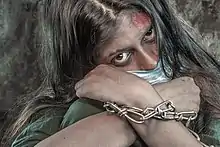
The threat to sustainable development is conflict, insecurities, weak institution and limited access to Justice.[43]
The global COVID-19 pandemic is predicted to increase the frequency of conflicts as countries blame others for their situation.[44] It is also expected that global peace and security will be threatened with over 60% countries risking the spread of COVID-19 in prisons due to overcrowding.[45]
Links with other SDGs
The Sustainable Development Goals are not taken as being completely independent one from the other, but rather as being closely linked. In this way, media development enhances freedom of speech, peace, but also contributes to sustainability, poverty eradication and human rights.[46] Fostering peace and inclusive societies can help reduce inequalities (SDG10) and help economies prosper (SDG8).[47] The 2012 outcome document of the United Nations Summit on the 2030 Agenda considers that sustainable development can not be achieved without building peaceful, just and inclusive societies and addressing issues of corruption, poor governance, insecurity and injustice.[6]
Organizations
UN organizations
The United Nations Development Programme (UNDP) is the United Nations global development network which is concerned with SDG 16. Hence, the Program focuses on democratic governance and peace building.[48] The UNDP also works on conflict prevention by empowering youth, especially women. Also, they aim at supporting the frameworks and structure and by acting as mediators.[49]
UNESCO has revealed diverse contributions to improve the scope of SDG 16 including:
- UNESCO's communication and information sector is responsible for targets 16.3 (access to justice), 16.5 (anti-corruption and transparent and accountable institutions). It aims to: "foster intercultural dialogue, culture of peace and non-violence, and prevent violent extremism through global citizenship education; support free, independent and pluralistic media, ensure the safety of journalists; protect cultural and natural heritage, strengthen governance systems for culture and enhance fundamental freedoms."[50][51]
- Preventing violent extremism is a way to promote, in official wording, a "culture of peace and non-violence" for UNESCO. The Organization aims to prevent violent extremism by using education as a tool to strengthen global citizenship, by mobilizing youth, women and other stakeholders to take actions, online and offline, to prevent and respond to violent extremism and radicalization on the Internet.[52]
- Freedom of speech - UNESCO, as the United Nations agency with the specific mandate to promote "the free flow of ideas by word and image", supports a free, independent and pluralistic media in print, broadcast and on the Internet.[46]
NGOs and foundations
- Justice Rapid Response is the only global facility that provides rapidly deployable experts in a wide range of highly specialized fields to assist with investigations in situations where war crimes, genocide, crimes against humanity, and serious human rights violations may have occurred.[53]
- The international peacebuilding organization Saferworld have pioneered a localization approach for SDG16+ – in an attempt to promote national ownership of commitments made under SDG16 and within the wider 2030 Agenda to build peaceful, just and inclusive societies.[54]
- The anti-corruption non-governmental organization Transparency International monitors corruption in over a hundred countries and aims to "gives voice to the victims and witnesses of corruption" and "stop the abuse of power, bribery and secret deals". The Organization launched the Corruption Perceptions Index in 1995.[55]
- Reporters Without Borders is a French "independent" non-governmental organization with consultative status at the United Nations. The NGO promotes freedom of information and safety of journalists. RSF Advocates worldwide for international and national legislation on freedom of information and protection of journalists.[56] It has put together the 2018 World Press Freedom Index as a basis to analyze the state of freedom of expression.[57]
- The World Wide Web Foundation is an association that promotes digital equality, access to information, and the open web as a "public good and a basic right". It advocates for public policies in over a dozen countries.[58]
US Based Organizations
In the US there are over thirty thousand tax-exempt organizations working on issues related to UN SDG 16, according to data filed with the Internal Revenue Service –IRS and aggregated by X4Impact.[59] X4Impact, with the support of the Rockefeller Foundation, Ford Foundation,[60] Hewlett Foundation,[61] and Giving Tech Labs, created a free online interactive tool Peace, Justice and Strong Institutions in the US. This online tool enables users to see indicators related to the correctional system nationally and by state, as well as relevant information for over two thousand tax-exempt organizations in the US working on issues related social justice, civil rights, and criminal justice. The nonprofit data in the tool is updated every 15 days while the indicators are updated annually.
Food security can play an important role in preventing conflict and distress migration.[62]
References
- "Goal 16". United Nations Department of Economics and Social Affairs. Retrieved 11 August 2021.
{{cite web}}: CS1 maint: url-status (link) - United Nations (2017) Resolution adopted by the General Assembly on 6 July 2017, Work of the Statistical Commission pertaining to the 2030 Agenda for Sustainable Development (A/RES/71/313)
- un [un.women.org un.women.org]. Retrieved 16 February 2022.
{{cite web}}: Check|url=value (help); Missing or empty|title=(help) - undp https://www.ng.undp.org. Retrieved 16 February 2022.
{{cite web}}: Missing or empty|title=(help) - unodc [unodc.org unodc.org]. Retrieved 16 February 2022.
{{cite web}}: Check|url=value (help); Missing or empty|title=(help) - United Nations (2015) Resolution adopted by the General Assembly on 25 September 2015, Transforming our world: the 2030 Agenda for Sustainable Development (A/RES/70/1)
- United Nations (2017) Resolution adopted by the General Assembly on 6 July 2017, Work of the Statistical Commission pertaining to the 2030 Agenda for Sustainable Development (A/RES/71/313)
- "Goal 16 | Department of Economic and Social Affairs". sdgs.un.org. Retrieved 25 April 2022.
- "Global study on homicide". United Nations : Office on Drugs and Crime. Retrieved 8 May 2022.
- "Goal 16 | Department of Economic and Social Affairs". sdgs.un.org. Retrieved 8 May 2022.
- "GLOBAL STUDY ON HOMICIDE 2019 Homicide trends, patterns and criminal justice response" (PDF). Retrieved 8 May 2022.
- "UNODC study shows that homicide rates are highest in parts of the Americas and Africa". United Nations : Office on Drugs and Crime. Retrieved 8 May 2022.
- Shalomov, Yulia (29 June 2021). "Revitalizing Progress for SDG 16 on Peace, Justice and Inclusion". IPI Global Observatory. Retrieved 8 May 2022.
- Ritchie, Roser, Mispy, Ortiz-Ospina. "Measuring progress towards the Sustainable Development Goals." (SDG 16) SDG-Tracker.org, website (2018)
- Gengler, Justin J.; Alkazemi, Mariam F.; Alsharekh, Alanoud (17 November 2018). "Who Supports Honor-Based Violence in the Middle East? Findings From a National Survey of Kuwait". Journal of Interpersonal Violence. 36 (11–12): NP6013–NP6039. doi:10.1177/0886260518812067. PMID 30449232. S2CID 53948129.
- un [un.women.org un.women.org]. Retrieved 16 February 2022.
{{cite web}}: Check|url=value (help); Missing or empty|title=(help) - undp.org https://www.ng.undp.org.
{{cite web}}: Missing or empty|title=(help) - Gengler, Justin J.; Alkazemi, Mariam F.; Alsharekh, Alanoud (17 November 2018). "Who Supports Honor-Based Violence in the Middle East? Findings From a National Survey of Kuwait". Journal of Interpersonal Violence. 36 (11–12): NP6013–NP6039. doi:10.1177/0886260518812067. PMID 30449232. S2CID 53948129.
- Gulesci, Selim; Puente- Beccar, Manuela; Ubfal, Diego (5 August 2021). "Can youth empowerment programs reduce violence against girls during the COVID-19 pandemic?". Journal of Environmental Pathology and Toxicology. 153 (5): 327–339. doi:10.1016/j.jdeveco.2021.102716. PMC 8536542. PMID 102716. S2CID 239459961.
- unodc [unodc.org unodc.org]. Retrieved 16 February 2022.
{{cite web}}: Check|url=value (help); Missing or empty|title=(help) - "SDG16 Data Initiative 2017 Global Report". SDG16 Report. 16 November 2017. Archived from the original on 23 July 2017. Retrieved 16 November 2017.
- "Progress for Every Child in the SDG Era" (PDF). UNICEF. Retrieved 2 April 2018.
- M'jid, Najat Maalla (10 September 2020). "Hidden scars: the impact of violence and the COVID-19 pandemic on children's mental health". Child and Adolescent Psychiatry and Mental Health. 33: 33. doi:10.1186/s13034-020-00340-8. PMC 7483042. PMID 32934663.
- [un.org/sdg "Sustainable development goals"]. Un. Retrieved 16 February 2022.
{{cite web}}: Check|url=value (help) - Institute for Economics and Peace (March 2019). "SDG16+ Progress Report" (PDF). economicsandpeace.org. Retrieved 8 May 2022.
- United Nations Economic and Social Council (2020) Progress towards the Sustainable Development Goals Report of the Secretary-General, High-level political forum on sustainable development, convened under the auspices of the Economic and Social Council (E/2020/57), 28 April 2020
- "— SDG Indicators". unstats.un.org. Retrieved 9 May 2022.
- "Our World in Data". SDG Tracker.
{{cite web}}: CS1 maint: url-status (link) - Manby, Bronwen (24 December 2020). "The Sustainable Development Goals and 'legal identity for all': 'First, do no harm'". World Development. 139 (3): 106–107. doi:10.1016/j.worlddev.2020.105343. PMID 105343. S2CID 233752128. Retrieved 22 October 2021.
- "Progress for Every Child in the SDG Era" (PDF). UNICEF. Retrieved 2 April 2018.
- Nations, United. "Universal Declaration of Human Rights". United Nations. Retrieved 8 May 2022.
- unesdoc.unesco.org https://unesdoc.unesco.org/ark:/48223/pf0000369160. Retrieved 8 May 2022.
{{cite web}}: Missing or empty|title=(help) - Spring, Prospects for Political Reform Post Arab. "Nadia al-Sakkaf". The Washington Institute. Retrieved 8 May 2022.
- Botero, Juan Carlos; Pinzon-Rondon, Angela Maria; Pratt, Christine S. (7 January 2016). "How, When and Why Do Governance, Justice and Rule of Law Indicators Fail Public Policy Decision Making in Practice?". Hague Journal on the Rule of Law. 8: 51-74. doi:10.1007/s40803-015-0020-8. S2CID 156433393.
- "United Nations (2018) Economic and Social Council, Conference of European Statisticians, Geneva," (PDF). United Nations (SDG 16) Custodian Agencies" (PDF)" (PDF). UNECE. Retrieved 23 September 2020.
{{cite web}}: CS1 maint: url-status (link) - "High-level Political Forum - Sustainable Development Knowledge Platform". United Nations. United Nations. Retrieved 8 September 2020.
{{cite web}}: CS1 maint: url-status (link) - Division, United Nations Statistics. "SDG Indicators – SDG Indicators". United Nations.
- "UN Plan of Action on the safety of journalists and the issue of impunity". unesdoc.unesco.org. 2016. Retrieved 3 November 2020.
{{cite web}}: CS1 maint: url-status (link) - "International Programme for the Development of Communication - Areas of Work". UNESCO. 21 April 2017. Retrieved 3 November 2020.
{{cite web}}: CS1 maint: url-status (link) - For international-level indicators see: "Journalists' Safety Indicators: international level, based on the UNESCO's Media Development Indicators" (PDF). UNESDOC Digital Library. Retrieved 11 August 2021.
{{cite web}}: CS1 maint: url-status (link) - For national-level indicators see: "Journalists' Safety Indicators: national level; based on the UNESCO's Media Development Indicators" (PDF). UNESDOC Digital Library. Retrieved 11 August 2021.
{{cite web}}: CS1 maint: url-status (link) - "About the IPDCtalks". UNESCO.
- un [un.org/sustainabledevelopment un.org/sustainabledevelopment]. Retrieved 16 February 2022.
{{cite web}}: Check|url=value (help); Missing or empty|title=(help) - Leal Filho, Walter; Brandli, Luciana Londero; Lange Salvia, Amanda; Rayman-Bacchus, Lez; Platje, Johannes (1 July 2020). "COVID-19 and the UN Sustainable Development Goals: Threat to Solidarity or an Opportunity?". Sustainability. 12 (13): 5343. doi:10.3390/su12135343. ISSN 2071-1050. S2CID 225547434.
- "The sustainable development goals report 2020" (PDF).
{{cite web}}: CS1 maint: url-status (link) - "Fostering Freedom of Expression". UNESCO. 30 January 2013.
- "Background of the Sustainable Development Goals". UNDP. Archived from the original on 7 November 2017. Retrieved 27 April 2018.
- See official website: Archived 30 April 2018 at the Wayback Machine
- "Conflict prevention – UNDP". UNDP.
- "UNESCO moving forward the 2030 Agenda for Sustainable Development" (PDF). UNESDOC Digital Library. Retrieved 11 August 2021.
{{cite web}}: CS1 maint: url-status (link) - "Communication and Information – United Nations Educational, Scientific and Cultural Organization". UNESCO.
- "Youth and violent extremism on social media: mapping the research" (PDF). UNESDOC Digital Library. Retrieved 11 August 2021.
{{cite web}}: CS1 maint: url-status (link) - "Home". Justice Rapid Response. Retrieved 11 August 2021.
{{cite web}}: CS1 maint: url-status (link) - "Putting SDG16+ into practice". saferworld.org.uk. Retrieved 11 August 2021.
{{cite web}}: CS1 maint: url-status (link) - "Home". transparency.org. Retrieved 11 August 2021.
{{cite web}}: CS1 maint: url-status (link) - "RSF". Bienvenue sur le site de Reporter sans frontières – Reports Without Borders.
- "RSF Index 2018: Hatred of journalism threatens democracies". Reports Without Borders. 23 April 2018.
- "About". World Wide Web Foundation.
- "Press Release: X4Impact, a Market Intelligence Platform for Social Innovation, Announced U.S. Launch During the 2020 Un General Assembly - NextBillion". nextbillion.net. Retrieved 17 November 2021.
- X4Impact. "Ford Foundation Fuels Tech for the Public Interest with X4Impact". www.prnewswire.com. Retrieved 17 November 2021.
- "Press Release: Hewlett Foundation Becomes X4Impact Founding Partner to Advance Technology for the Public Interest With Focus on Entrepreneurs Creating Tech for Good Solutions - NextBillion". nextbillion.net. Retrieved 17 November 2021.
- fao https://www.fao.org/sustainabledevelopment. Retrieved 16 February 2022.
{{cite web}}: Missing or empty|title=(help)
